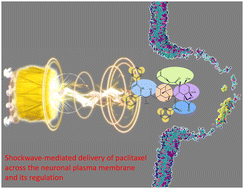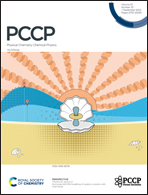Molecular modelling of shockwave-mediated delivery of paclitaxel aggregates across the neuronal plasma membrane†
Abstract
Shock-assisted paclitaxel (PTX) transport across the blood–brain barrier offers a promising treatment strategy for brain tumors. Here, based on a realistically complex human brain plasma membrane (PM) model, we investigated the dynamic transmembrane behavior of a PTX cluster by shock induced bubble collapse, focusing on the effect of impulse (I), bubble diameter (D) and arrays. The results show that all three factors can control the transport depth (ΔDPM) of PTX. For a fixed D, the ΔDPM grows exponentially with I, ΔDPM ∼ exp (I), and eventually reaches a critical depth. But the depth, ΔDPM, can be adjusted linearly in a wider range of D. This mainly depends on the size of jets from bubble collapse. For bubble arrays, the bubbles in series can transport PTX deeper than a single bubble, while the parallel does the opposite. In addition, only PTX clusters in the range of jet action can be successfully transported. Finally, the absorption of PTX clusters was examined via recovery simulation. Not all PTX clusters across the membrane can be effectively absorbed by cells. The shallow PTX clusters are quickly attracted by the membrane and embedded into it. The critical depth at which PTX clusters can be effectively absorbed is about 20 nm. These molecular-level mechanisms and dynamic processes of PTX clusters crossing the PM membrane may be helpful in optimizing the application of shock-induced bubble collapse for the delivery of PTX to tumor cells.



 Please wait while we load your content...
Please wait while we load your content...